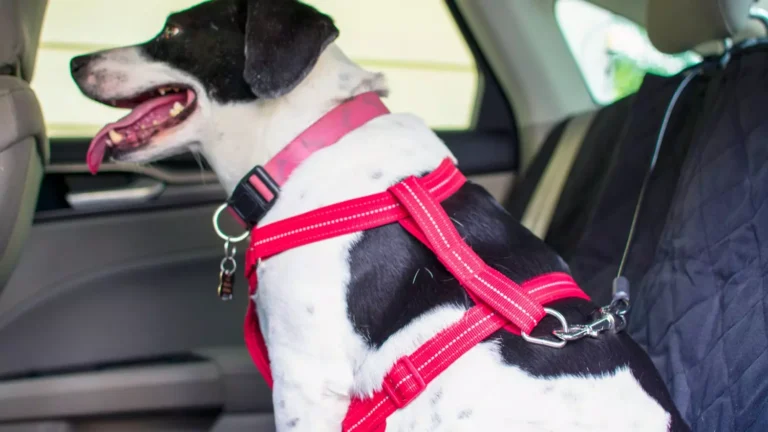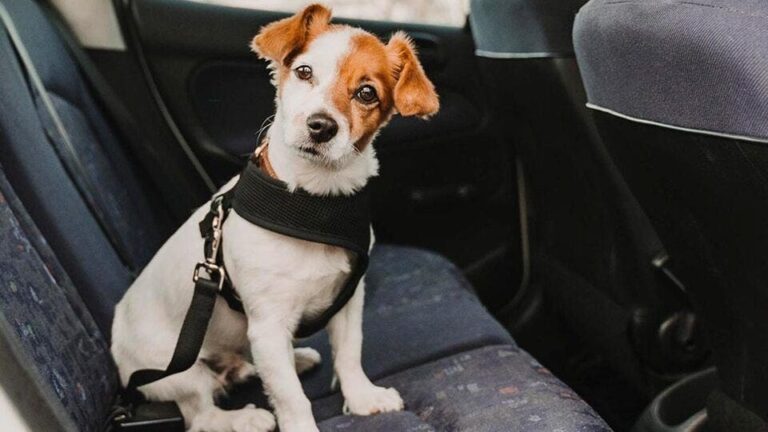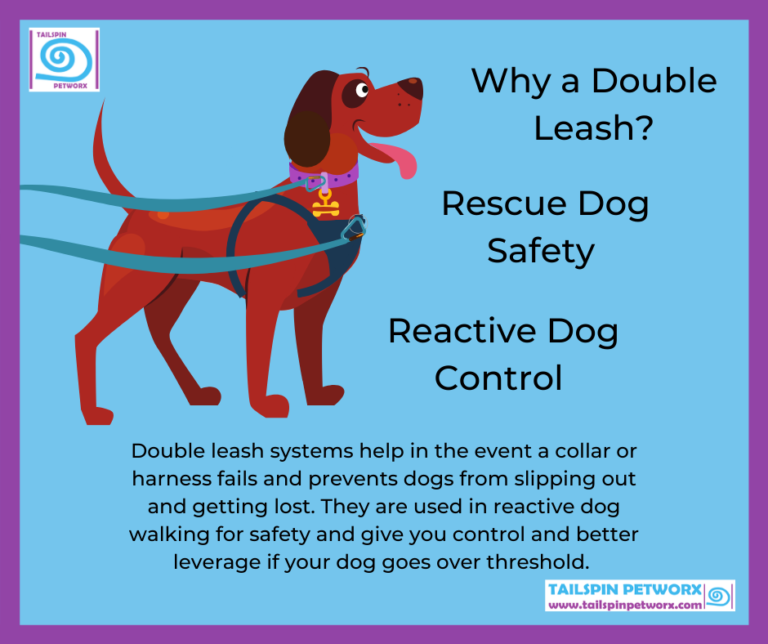Is It Ok to Drive With Dog in Front Seat? Safety Tips Revealed
It is generally not safe to drive with a dog in the front seat. This can cause distractions and increase accident risk.
Driving with a dog in the front seat can pose significant dangers. Dogs can become a distraction, leading to accidents. They might interfere with the driver’s control over the vehicle, causing sudden swerves or stops. In an accident, airbags can injure or even kill a dog sitting in the front seat.
To ensure safety, secure your dog in the back seat using a pet seat belt or carrier. This minimizes distractions and protects both you and your pet. Keeping your dog in the back seat also reduces the risk of injury in case of a collision. Prioritize safety for a comfortable and secure journey.

Credit: www.amazon.com
The Risks Of Dogs In The Front Seat
Driving with a dog in the front seat can be dangerous. Many pet owners do not realize the risks involved. Understanding these risks is crucial for both your safety and your dog’s safety.
Distraction Dangers
A dog in the front seat can be a significant distraction. Dogs can move around and seek attention. This can make it hard for you to focus on the road. A distracted driver is more likely to have an accident. Even a split-second distraction can cause a serious crash.
- Your dog might bump into controls.
- The dog might block your view.
- Barking or sudden movements can startle you.
These distractions increase the risk of accidents. It is safer to keep your dog restrained in the back seat.
Airbag Deployment Injuries
Front seat airbags are designed for adults, not dogs. In a crash, the airbag can deploy with great force. This can injure or even kill a d

Credit: www.instagram.com
Legal Implications Of Unrestrained Pets
Driving with your dog in the front seat can seem fun. But it can have serious legal consequences. Many places have strict laws about pets in cars. These laws aim to keep everyone safe.
An unrestrained pet can lead to fines and affect your insurance. Knowing the legal implications can help you avoid trouble. Let’s explore the key areas affected by unrestrained pets.
Traffic Violations And Fines
Many states and countries have laws against unrestrained pets in cars. These laws often classify it as a traffic violation. This means you can get a ticket if your dog is not properly secured.
Fines for these violations can be hefty. They range from $50 to $200 or even more. In some places, repeat offenses can lead to higher fines. It’s important to check your local laws.
Here’s a table showing some state fines:
| State | Fine Amount |
|---|---|
| California | $50 – $100 |
| New York | $100 – $200 |
| Florida | $75 – $150 |
Impact On Insurance Policies
Insurance companies consider unrestrained pets a risk. They can affect your insurance premiums. If your pet causes an accident, your insurance may not cover it.
Some insurance policies have specific clauses about pets. It’s important to read your policy carefully. You might need to pay out-of-pocket for damages caused by an unrestrained pet.
Keeping your pet restrained can help avoid these problems. It can also make your insurance claims process smoother.
In summary, understanding the legal implications of unrestrained pets can save you money and trouble. Always keep your pet safe and secured in your car.
Safety Tips For Traveling With Dogs
Driving with your furry friend can be fun. But safety is crucial. Here are some essential tips to ensure both you and your dog have a safe journey.
Proper Restraint Techniques
Using proper restraint techniques can prevent accidents. A loose dog can be a distraction and a danger. Use a dog seat belt or a harness. These tools keep your dog secure and safe.
Another option is a pet carrier. Make sure it is crash-tested and fits your dog comfortably. Place the carrier in the back seat for added safety.
For larger dogs, a crate is ideal. Secure the crate to prevent it from moving during sudden stops.
Choosing The Right Gear
Choosing the right gear is essential for your dog’s safety. Here is a table of recommended gear:
| Gear | Description | Benefits |
|---|---|---|
| Dog Seat Belt | A belt that attaches to your dog’s harness | Keeps dog in place |
| Pet Carrier | A small enclosure for your dog | Secures small dogs |
| Crate | A larger enclosure for big dogs | Provides safety and comfort |
Always choose gear that is crash-tested. It should be durable and comfortable for your dog. Avoid using collars for restraint. They can cause injury during a sudden stop.
Understanding Dog Behavior During Car Rides
Driving with your dog in the front seat can be a delightful experience. But it’s important to understand how your dog behaves during car rides. Dogs show various behaviors that can signal their comfort or discomfort. Knowing these behaviors can make the journey safer and more enjoyable for both you and your pet.
Stress Signals To Watch For
Dogs can exhibit several stress signals during car rides. These signals can indicate that your dog is feeling uneasy or scared.
- Panting: If your dog is panting excessively, it might be a sign of stress.
- Whining: Dogs often whine when they are uncomfortable or anxious.
- Shaking: Shivering or shaking can be a clear sign of fear.
- Lip Licking: Excessive lip licking can indicate nervousness.
- Pacing: If your dog is constantly moving around, it may be stressed.
Training For Car Travel
Training your dog for car travel can make a huge difference. Proper training can help your dog feel more comfortable and secure during rides.
- Start Slow: Begin with short car trips to help your dog get used to the motion.
- Use Positive Reinforcement: Reward your dog with treats and praise for calm behavior.
- Secure Your Dog: Use a dog seat belt or crate to keep your dog safe and comfortable.
- Make it Fun: Bring your dog’s favorite toys or blankets to make the car feel like a safe space.
- Practice Regularly: Frequent short trips can help your dog build confidence and reduce anxiety.
Understanding your dog’s behavior during car rides is crucial. Watch for stress signals and train your dog properly. This ensures safe and enjoyable journeys for both of you.
Alternatives To Front Seat Travel
Driving with your dog in the front seat can be dangerous. There are many safer alternatives for your furry friend. Explore these options to ensure a safe and comfortable journey for both you and your dog.
Back Seat Barriers
Back seat barriers are a great option. They keep your dog safely in the back seat. These barriers prevent your dog from jumping into the front seat while driving.
Here are some benefits of back seat barriers:
- Safety: Reduces distractions for the driver.
- Comfort: Provides a dedicated space for your dog.
- Easy Installation: Most barriers are easy to set up and remove.
There are various types of back seat barriers:
| Type | Material | Features |
|---|---|---|
| Mesh Barriers | Fabric | Lightweight and breathable |
| Metal Barriers | Steel | Sturdy and durable |
Cargo Space Solutions
If you have an SUV or wagon, the cargo space is an excellent alternative. This area is usually spacious and allows your dog to move around comfortably.
Consider these tips for using cargo space:
- Use a Crate: A crate provides a confined space for your dog.
- Install a Gate: A gate keeps your dog in the cargo area.
- Use Soft Bedding: Soft bedding makes the space more comfortable.
Benefits of using cargo space:
- More Space: Offers more room for your dog.
- Better Visibility: Your dog can see through the rear window.
- Reduced Distractions: Keeps your dog away from the driver.
Choosing the right alternative ensures safety and comfort for your dog. Whether it’s a back seat barrier or cargo space, make your choice wisely.
Emergency Protocols For Road Accidents
Driving with your dog in the front seat can be risky. If an accident happens, knowing what to do is crucial. This section covers emergency protocols to keep your pet safe.
First Aid For Injured Pets
First aid can be the difference between life and death for your pet. Keep a pet first aid kit in your car. Here are some items to include:
- Gauze for wrapping wounds
- Hydrogen peroxide for cleaning cuts
- Adhesive tape for bandages
- Scissors for cutting bandages
Check your pet for injuries. Look for bleeding or broken bones. Wrap any wounds with gauze. Use adhesive tape to secure the gauze.
If your pet is bleeding, apply pressure to the wound. This helps stop the bleeding. Be gentle to avoid hurting your pet more.
Emergency Contacts And Procedures
Having emergency contacts can save time. Create a list of important contacts. Include:
| Contact | Phone Number |
|---|---|
| Veterinarian | +1-800-123-4567 |
| Emergency Animal Hospital | +1-800-987-6543 |
| Animal Poison Control | +1-800-222-1222 |
Call your veterinarian first. Explain the situation clearly. Follow their advice. If your vet is unavailable, call an emergency animal hospital. Describe your pet’s injuries. They will guide you on what to do next.
Keep your pet calm. Talk to them in a soothing voice. Avoid sudden movements. This helps reduce their stress.
Expert Opinions On Dogs And Car Safety
Driving with a dog in the front seat can be risky. Experts share their advice on keeping your furry friend safe during car rides.
Veterinary Advice
Veterinarians stress the importance of restraining dogs in cars. An unrestrained dog can get hurt in sudden stops or crashes. Dr. Sarah Johnson, a renowned vet, says: “A dog in the front seat can be a major distraction.” She recommends using a dog seatbelt or crate. This helps to keep your pet secure and reduce potential injuries.
Vets also warn about airbags. Airbags can seriously hurt a dog sitting in the front seat. Dr. Emily Roberts advises: “Place your dog in the back seat for better safety.” This is crucial, especially for small breeds. They are more vulnerable to the impact of an airbag.
Automotive Safety Expert Insights
Car safety experts share similar concerns. They emphasize the importance of proper pet restraints. John Miller, an automotive safety specialist, notes: “An unrestrained dog can become a projectile in a crash.” This can cause severe injuries to both the dog and passengers.
Experts also highlight the legal implications. Some regions have laws about pet restraints in cars. According to safety consultant Jane Doe: “Failing to secure your pet can result in fines.” She recommends checking local laws to ensure compliance.
To summarize the expert advice, here is a table with key points:
| Expert | Advice |
|---|---|
| Dr. Sarah Johnson | Use a dog seatbelt or crate |
| Dr. Emily Roberts | Place your dog in the back seat |
| John Miller | Restrain dogs to prevent them becoming projectiles |
| Jane Doe | Check local laws for pet restraints |
Following these tips can ensure a safer ride for both you and your furry friend. Always prioritize safety when traveling with pets in your car.

Credit: doorcountypulse.com
Making The Best Decision For Your Pet
Driving with your dog in the front seat can be a tricky choice. It’s important to ensure your pet’s safety and comfort. This section will guide you through making the best decision for your furry friend.
Assessing Your Dog’s Needs
Understanding your dog’s needs is the first step. Some dogs feel anxious in cars. Others might be excited and restless. Assessing your dog’s behavior is crucial. Observe how your dog reacts during car rides.
Consider your dog’s size and breed. Smaller dogs might feel safer in a special car seat or carrier. Larger dogs may need more space to lie down. Think about what makes your dog comfortable.
Health issues are another important factor. Dogs with joint problems might struggle in cramped spaces. Older dogs may need extra support. Always prioritize their health and well-being.
Personal Stories And Considerations
Many pet owners share experiences about driving with their dogs. Some find the front seat convenient. Others believe the back seat is safer. Listening to different stories helps in making an informed decision.
A friend of mine has a small dog named Max. Max loves sitting in the front seat. He feels safe and can look out the window. Another friend has a large dog named Bella. Bella prefers the spacious back seat. She can stretch out and relax.
Consider your car’s layout. Some cars have airbags that might be dangerous for dogs. Check if your car’s safety features are suitable. Use pet seat belts or harnesses for added safety.
| Dog Size | Best Seat | Considerations |
|---|---|---|
| Small | Front Seat | Use a car seat or carrier |
| Medium | Front or Back Seat | Use a harness or pet seat belt |
| Large | Back Seat | Ensure enough space to lie down |
Making the best decision for your pet involves understanding their needs and considering personal experiences. Always aim for safety and comfort for your beloved furry friend.
Frequently Asked Questions
Can I Put A Dog In The Front Seat Of My Car?
Yes, you can put a dog in the front seat. Use a pet seat belt or carrier for safety. Ensure airbags are deactivated.
Can A Dog Sit On The Drivers Lap While Driving?
No, a dog should not sit on the driver’s lap while driving. It’s unsafe and can cause distractions.
In What States Is It Illegal To Have An Unrestrained Dog In A Car?
Several states have laws against unrestrained dogs in cars. These include Connecticut, Hawaii, Maine, Massachusetts, Minnesota, New Hampshire, and Rhode Island. Always check local regulations for details.
How To Safely Drive With A Dog In A Car?
Secure your dog with a harness or crate. Keep them in the back seat. Use dog barriers for larger breeds. Avoid letting them stick heads out the window. Take regular breaks for exercise and hydration.
Conclusion
Driving with a dog in the front seat can be risky. It’s best to prioritize safety for both driver and pet. Use a pet seatbelt or crate to ensure a secure ride. Proper safety measures can prevent accidents and injuries.
Always consider the well-being of your furry friend while driving.
- Can I Get in a Taxi Without a Car Seat? - January 26, 2025
- Can I Get Chlamydia From a Toilet Seat? - January 26, 2025
- Can I Get an Uber With a Car Seat? - January 26, 2025






